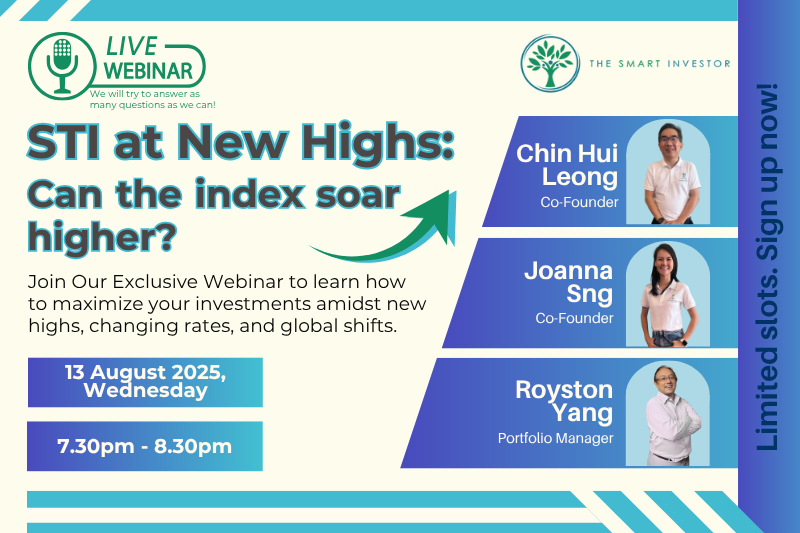The Federal Reserve finally reduced interest rates on 17 September 2025.
With more rate cuts ahead, investors might expect all stocks to appreciate.
However, not all stocks benefit equally from lower rates; some businesses face margin pressure or lower earnings in a lower-rate world.
Here, we showcase three Singapore stocks that could come under pressure: Oversea-Chinese Banking Corporation Ltd (OCBC), Great Eastern Holdings (GE), and Singapore Airlines (SIA).
OCBC: Lower Interest Earnings Outweigh Loan Growth
We begin with Oversea-Chinese Banking Corporation Limited (SGX: O39), or OCBC, where lower interest rates could weigh on its net interest margin and reduce profitability.
The bread and butter for banks comes from the spread between interest charged on loans and interest paid on deposits.
Known as net interest margin (NIM), this metric has been steadily declining for OCBC since a high of 2.31% in 4Q2022.
This contraction of NIM is due to lower interest rates, which narrow spreads between lending and deposit costs, reducing earnings.
While banks typically have other non-interest business segments, such as asset management and trading, to offset NIM pressure, OCBC still relies primarily on net interest income (NII).
NII for 2Q2025 was S$2.3 billion (64.4% of total income), declining 6% year on year (YoY) from S$2.43 billion, and decreasing 3% on a quarter-to-quarter (QoQ) basis.
The bank reported NIM of 1.92%, with management lowering full-year guidance to a range of 1.9% to 1.95%.
Management also indicated that loan growth will not offset the impact of lower rates, leading to lower NII.
Lower NII has resulted in a cut to OCBC’s dividend.
An interim dividend of S$0.41 per share was declared for 1H2025, representing a YoY decline of 6.8% compared to 1H2024’s payment of S$0.44.
The payout ratio remains constant at 50%, highlighting the negative impact of lower NII due to lower rates.
Great Eastern Holdings: Insurers suffer from Lower Investment Income
Great Eastern Holdings Ltd (GE) (SGX: G07) might face earnings pressure due to lower interest rates.
Insurance companies make money by selling insurance policies to customers and investing the premiums received into financial assets (usually bonds and fixed-income instruments).
These policies represent future liabilities.
GE profits if the investment income from these assets exceeds its claims and expenses (profit from insurance business).
Lower interest rates increase the value of the insurer’s future liabilities while lowering reinvestment yields on newer bonds, reducing profits.
Lower interest rates can also lower yields on GE’s own investment portfolio, where GE uses its capital base to invest in assets (Profit from Shareholders’ Fund).
This could limit investment income growth.
For 1H2025, GE’s net profit increased 1% YoY to S$593.7 million.
Profit from its insurance business declined 8% YoY to S$415.2 million, but was offset by strong growth from its shareholders’ fund, with profit from this segment increasing 32% YoY to S$178.5 million (30.1% of total profits).
While the insurer’s latest results remain resilient, investors should be mindful of how lower rates could impact profits, especially for its insurance business.
New business embedded value (NBEV), reflecting future profits from new policies underwritten during 1H2025, surged 16% YoY to S$316.5 million.
This growth in NBEV, combined with higher-margin insurance policies such as life and health products, will help buffer against lower interest rates, as these policies rely more on risk coverage fees and insurance charges.
Singapore Airlines: Possible turbulence ahead
Singapore Airlines Ltd (SGX: C6L), or SIA, might face earnings pressure due to lower rates.
Lower rates may signal slower global economic growth, leading to weaker passenger demand and cargo volumes.
In August 2025, the group’s passenger load factor (PLF) was 88.0%, up from 85.7% YoY but down from June’s 88.7% and July’s 88.5%.
Cargo load factor (CLF) was 55.2% for August 2025, down from 56.1% YoY and June’s 56.4%.
In its latest quarter (1QFY2025/2026), SIA reported revenue of S$4.8 billion, representing an increase of 1.5% YoY.
Operating profit declined 14% YoY to S$404.5 million due to intensifying competition as rivals increased seat capacity, and higher non-fuel costs.
Net financing cost was S$52.9 million, a stark contrast to net interest income of S$22.2 million in 1QFY2024/2025.
This reflects lower interest income from lower rates.
SIA could benefit from lower global rates through lower financing costs when it refinances its total debt of S$11.5 billion.
Get Smart: Monitor and Rebalance Your Portfolio
Not all stocks benefit from lower rates.
While lower interest rates may fuel a REIT recovery, sectors like banking and insurance face headwinds.
Banks and insurers such as OCBC and Great Eastern may face margin pressure, while cyclicals like SIA could see weaker demand if rate cuts signal an economic downturn.
Investors can prepare by balancing exposure and focusing on resilience and income quality.
Monitor the fundamentals of businesses you own and consider diversifying into sectors with stable earnings and higher-quality income streams that benefit from lower rates.
Looking to start investing? Our beginner’s guide will show you how to make the best buying decision and make fewer mistakes. Click here to download for free now.
Follow us on Facebook, Instagram and Telegram for the latest investing news and analyses!
Disclosure: Wesley does not own shares in any of the companies mentioned.






